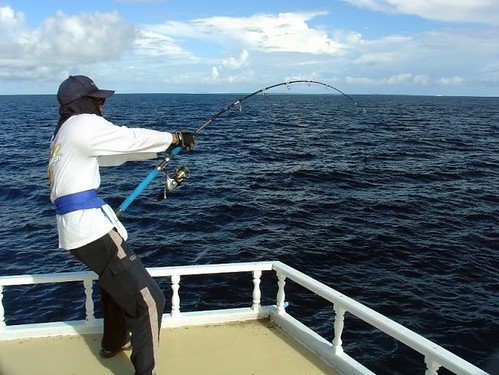
One of the more common methods of catching king salmon is drift fishing. The main concept is drifting a weight bumping along the bottom, followed by a section of leader with your terminal tackle. Keeping the lead tapping on the bottom every few feet of drift will let you know your hook is always floating in the fish zone. The other advantage of the drift fishing technique is that you know exactly how each drift feels and when it changes ever so slightly, you know that a fish likely has taken the hook.
Basic Drift Fishing Set-up
Tie an egg loop on an octopus style hook leaving the desired leader length. Either put yarn through the bait loop on the hook and a float on the leader in front of the hook, or
just fish with the yarn depending on the depth that you want the hook to pass through the hole. Tie the hook set-up and leader to a snap swivel and then tie the snap swivel to your main line. Put the desired amount of weight on the snap swivel to be able to feel the bottom lightly every three feet of drift. Some fishermen prefer a heavier drift or more frequent contact with the river bottom, while others prefer a lighter drift. You do not want so much weight that the set-up drags, nor so little that the set-up does not touch bottom, but use whatever works for you.
Basic Drift Fishing Casting
Because you have weighted your set-up to touch bottom every three feet of drift, it will be necessary to cast up stream at a 45 degree angle to allow time for your gear to hit bottom just before the line is out in front of you. That may not always be an option on some rivers if the bottom is snaggy, but at Lake Creek’s main tributaries, the bottom was perfect for getting the most drift out of each cast by starting the drift upstream. Maintaining tight lines, fish through the hole until it is obvious the set-up is not touching the bottom anymore. This happens at the end of the drift when the current starts swinging the set-up toward the bank.
Detecting the Bite
A king will occasionally take your set-up and about rip the rod from your hands. When this happens, it is easy to determine you have a fish on. More often though, you will be feeling the familiar drift that you have been focusing on feeling cast after cast and then something will change. The drift might feel heavier, or it might feel lighter. Either way, when something changes chances are good that a fish has picked up your set-up and setting the hook becomes critical before the fish rids itself of the hook.
Setting the Hook
When a fish takes your set-up, do not hesitate to set the hook hard with a long strike. If the hook set is not solid, quickly take up any slack that may have been in your line and set the hook again. Once you feel a solid hook set, there is no need to continue setting the hook – “Set It and Forget It”. You should consider fishing with barbless hooks if you are planning to release the fish. The hooks are much easier to remove from the fish and should you hook yourself or one of your fishing partners, you will be glad it was not barbed.
Fighting the Fish
When you hook a monster king, or even a medium-sized king, be prepared for a serious fight. The Lake Creek kings not only have incredible power and endurance, but if you watched our DVD, Alaska’s Lake Creek King Salmon Float Trip, you have also seen they spend more time in the air than a large mouth bass. Use your rod and your reel’s drag system to make the fish do some of the work. Have your drag set such that with effort the fish can run, but not so light or heavy that the fish will spool you or break your line. At the right drag setting and using your rod to work the fish, it is uncomfortable for the fish to continue running. More than likely within the first 50 or 60 feet of running, the fish will realize that it is easier to turn and either stop or come back toward you. If you want to feel all the fight the fish has in it, keep your rod tip high and plenty of pressure on the fish, but be prepared to lose the fish or become exhausted!
If you want to land the fish quickly and efficiently, once the fish turns toward you, lower your rod tip near the water surface and aim it upstream while maintaining some bend and gently pressure the fish using the rod to “Ease the Fish” toward you. The technique of easing the fish toward you will usually be the best method to keep the fish relaxed with less desire to jump and more willing to come over to the shore.
Landing the Fish
There is no need to use a net if you are fishing an area where the water becomes shallow near the shore, which is the case at all the main tributaries of Lake Creek. Once you have the fish in less than six inches of water depth, allow the fish to lie over on its side, and it will generally remain still enough to allow for a quick hook removal.
0 comments:
Post a Comment